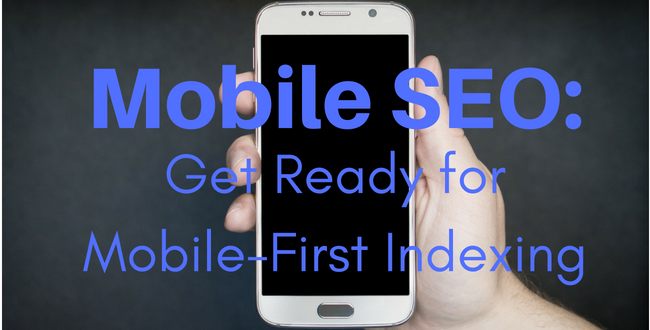
Mobile SEO: Get Ready for Mobile-First Indexing
Imagine life without a smartphone… That’s okay – I can’t either and that's because smartphone use has been on the rise for years, and with that - mobile search traffic. In 2017, 57% of all search traffic came from a mobile device or tablet, so what exactly does this mean for your SEO strategy? It means you’re going to need to up your mobile SEO game if you haven’t already!
Currently, search engines crawl the desktop version of a website in order to index and rank that site for SERPs. What you might not know though, is that this won’t be the case much longer with the introduction and rollout of Google’s mobile-first indexing. This isn't exactly new though, with Google first announcing that it would be experimenting with a mobile-first index in 2016 and finally starting to roll it out this past March. Google's overall thinking is to improve the mobile user’s search experience, helping them to better find what they need faster.
Most mobile searches are done through Google (over 90% of them!). It’s important to note that when Google says mobile, they mean smartphone. Google excludes tablets from the mobile category and that “unless you offer tablet-optimized content, you can assume that users expect to see your site as it would look on a desktop browser”. There won’t be separate indexes for desktop and mobile, so you’ll need to make sure the mobile version of your website is ready.
Mobile Website Configuration Options
If your website isn’t already mobile or you’re thinking about doing a major overhaul, there are 3 configuration options for mobile. You can choose from separate URLs, dynamic serving or responsive design.
Separate URLs
Using separate URLs means that every URL on your desktop version has a corresponding URL on the mobile version. For example, http://www.yourwebsite.com would look like http://m.yourwebsite.com. You’ll need to make sure all of your redirects from the desktop to the mobile version are correct and plan for managing content on both. As a best practice, whatever is available on the desktop version should also be accessible on the mobile version. It also requires the addition of link rel =“alternate” and “canonical” tags to let Google know to consider the different versions together as one and not as two separate pages.
Dynamic Serving
As opposed to separate URLS, a dynamic serving configuration has everything on one URL. You’ll need to have your website’s CSS and HTML written out for various devices. The CSS and HTML that loads will depend on the device the user is on. If don’t have a version ready for a device, then the user might get shown a less-than-perfect version of your website. You’ll also need to include a Vary header. A Vary header is extremely important because it lets Google know that there’s mobile content it needs to pull from somewhere else and to crawl for it.
Responsive Design
The third option for configuration is responsive design. Like a dynamic serving configuration, your desktop and mobile websites are also on the same URL. Instead of having to write out respective CSS and HTML for any and all devices, there’s one centralized source for your code. You’ll use CSS to optimize your website, so the content will adapt to whatever device the user is on. Just make sure to include the meta name =“viewport” tag when going with the responsive design option.
So, which configuration should you go with? Any of the 3 configuration options will work to make your website mobile. However, using responsive design provides a number of benefits and is less risky than the other options. It’s going to save you time and help you avoid some of the most common mistakes when it comes to mobile. Google also recommends going the responsive design route.
Mobile SEO Best Practices and Tactics
Aside from picking a configuration option, you’ll also want to optimize your website’s content for mobile. A lot of the SEO strategies that work for desktop versions will also apply to mobile versions, but there are still some other differentiating factors for mobile to keep in mind. I’ve gone ahead and created a list below of some of most important best practices and tactics to prepare your website for mobile-first indexing.
Run a Mobile Website Audit
First off, you want to make sure your robots.txt is good to go and that you remove any unplayable content like Flash videos. You can also use Google Search Console’s Mobile-Friendly Test Tool to see just how mobile-friendly your website is. Don’t forget to add structured data because search engines use this information to better understand what your website is about. In turn, users are given rich results or snippets when they search, which can push your website ahead.
Make Your Website Convenient
Give the people what they want – NOW! Over half of mobile users leave if your page takes more than 3 seconds to load. Page speed is critical and now a ranking factor for mobile searches. A great opportunity for page speed improvement are images. Resizing images and removing any unnecessary ones on your website is an easy way to decrease page size. Scalable Vector Graphics are also an option and work well with CSS as the images adjust to the screen size of the user’s device.
No one should struggle to read what’s on your website. You need to make sure your page is legible and can accomplish this by using easy to read font types and sizes. Screen space can be limited - be sure your titles and meta descriptions are concise and consistent. Pop-ups should be used thoughtfully and carefully if you have to use them. You want to maximize the visibility of your content as much as possible to your user.
Optimize for Local
Optimizing your website for local is essential, especially since 76% of people who search for something will visit a related business within a day. You can take advantage of all the “near me” searches in a number of ways. Building up local links, adding photos and making sure all of your information is updated in Google My Business are some things you can do if you haven’t already. You should also craft content with a local focus and as always, keep it relevant and interesting for your user.
Final Thoughts
Mobile has been on its way for a long time and now has very much arrived. While much of what you’re already doing with your SEO strategy will still be applicable with mobile first-indexing, there are definitely some things you’ll need to change or slightly adjust. Just remember to keep calm, identify what changes you’ll need to make, and stay updated.


